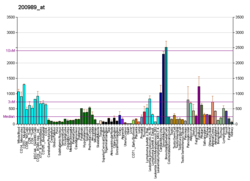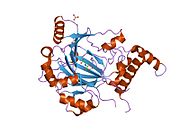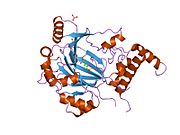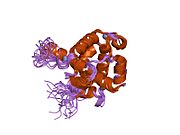
Tumor hypoxia is the situation where tumor cells have been deprived of oxygen. As a tumor grows, it rapidly outgrows its blood supply, leaving portions of the tumor with regions where the oxygen concentration is significantly lower than in healthy tissues. Hypoxic microenvironments in solid tumors are a result of available oxygen being consumed within 70 to 150 μm of tumor vasculature by rapidly proliferating tumor cells thus limiting the amount of oxygen available to diffuse further into the tumor tissue. In order to support continuous growth and proliferation in challenging hypoxic environments, cancer cells are found to alter their metabolism. Furthermore, hypoxia is known to change cell behavior and is associated with extracellular matrix remodeling and increased migratory and metastatic behavior.
Hypoxia-inducible factors (HIFs) are transcription factors that respond to decreases in available oxygen in the cellular environment, or hypoxia. They also respond to instances of pseudohypoxia, such as thiamine deficiency. Both hypoxia and pseudohypoxia leads to impairment of adenosine triphosphate (ATP) production by the mitochondria.

A basic helix–loop–helix (bHLH) is a protein structural motif that characterizes one of the largest families of dimerizing transcription factors. The word "basic" does not refer to complexity but to the chemistry of the motif because transcription factors in general contain basic amino acid residues in order to facilitate DNA binding.
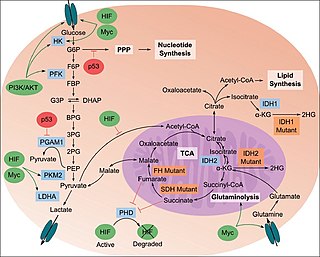
The study of the tumor metabolism, also known as tumor metabolome describes the different characteristic metabolic changes in tumor cells. The characteristic attributes of the tumor metabolome are high glycolytic enzyme activities, the expression of the pyruvate kinase isoenzyme type M2, increased channeling of glucose carbons into synthetic processes, such as nucleic acid, amino acid and phospholipid synthesis, a high rate of pyrimidine and purine de novo synthesis, a low ratio of Adenosine triphosphate and Guanosine triphosphate to Cytidine triphosphate and Uridine triphosphate, low Adenosine monophosphate levels, high glutaminolytic capacities, release of immunosuppressive substances and dependency on methionine.
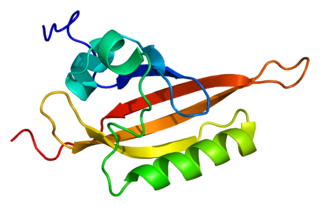
The ARNT gene encodes the aryl hydrocarbon receptor nuclear translocator protein that forms a complex with ligand-bound aryl hydrocarbon receptor (AhR), and is required for receptor function. The encoded protein has also been identified as the beta subunit of a heterodimeric transcription factor, hypoxia-inducible factor 1 (HIF1). A t(1;12)(q21;p13) translocation, which results in a TEL–ARNT fusion protein, is associated with acute myeloblastic leukemia. Three alternatively spliced variants encoding different isoforms have been described for this gene.

The Von Hippel–Lindau tumor suppressor also known as pVHL is a protein that, in humans, is encoded by the VHL gene. Mutations of the VHL gene are associated with Von Hippel–Lindau disease, which is characterized by hemangioblastomas of the brain, spinal cord and retina. It is also associated with kidney and pancreatic lesions.
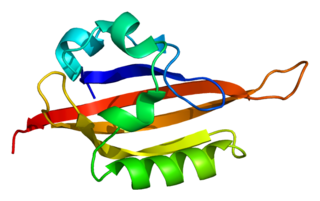
Endothelial PAS domain-containing protein 1 is a protein that is encoded by the EPAS1 gene in mammals. It is a type of hypoxia-inducible factor, a group of transcription factors involved in the physiological response to oxygen concentration. The gene is active under hypoxic conditions. It is also important in the development of the heart, and for maintaining the catecholamine balance required for protection of the heart. Mutation often leads to neuroendocrine tumors.

Hypoxia-inducible factor 3 alpha is a protein that in humans is encoded by the HIF3A gene.

Egl nine homolog 2 is a protein that in humans is encoded by the EGLN2 gene. ELGN2 is an alpha-ketoglutarate-dependent hydroxylase, a superfamily of non-haem iron-containing proteins.

Hypoxia-inducible factor prolyl hydroxylase 2 (HIF-PH2), or prolyl hydroxylase domain-containing protein 2 (PHD2), is an enzyme encoded by the EGLN1 gene. It is also known as Egl nine homolog 1. PHD2 is a α-ketoglutarate/2-oxoglutarate-dependent hydroxylase, a superfamily non-haem iron-containing proteins. In humans, PHD2 is one of the three isoforms of hypoxia-inducible factor-proline dioxygenase, which is also known as HIF prolyl-hydroxylase.

Egl nine homolog 3 is a protein that in humans is encoded by the EGLN3 gene. ELGN3 is a member of the superfamily of alpha-ketoglutarate-dependent hydroxylases, which are non-haem iron-containing proteins.

Hypoxia-inducible factor 1-alpha inhibitor is a protein that in humans is encoded by the HIF1AN gene.

Protein OS-9 is a protein that in humans is encoded by the OS9 gene.

"Basic helix-loop-helix family, member e41", or BHLHE41, is a gene that encodes a basic helix-loop-helix transcription factor repressor protein in various tissues of both humans and mice. It is also known as DEC2, hDEC2, and SHARP1, and was previously known as "basic helix-loop-helix domain containing, class B, 3", or BHLHB3. BHLHE41 is known for its role in the circadian molecular mechanisms that influence sleep quantity as well as its role in immune function and the maturation of T helper type 2 cell lineages associated with humoral immunity.

Sir Peter John Ratcliffe, FRS, FMedSci is a British physician-scientist who is trained as a nephrologist. He was a practising clinician at the John Radcliffe Hospital, Oxford and Nuffield Professor of Clinical Medicine and head of the Nuffield Department of Clinical Medicine at the University of Oxford from 2004 to 2016. He has been a Fellow of Magdalen College, Oxford since 2004. In 2016 he became Clinical Research Director at the Francis Crick Institute, retaining a position at Oxford as a member of the Ludwig Institute of Cancer Research and director of the Target Discovery Institute, University of Oxford.
Hypoxia-inducible factor-proline dioxygenase (EC 1.14.11.29, HIF hydroxylase) is an enzyme with systematic name hypoxia-inducible factor-L-proline, 2-oxoglutarate:oxygen oxidoreductase (4-hydroxylating). This enzyme catalyses the following chemical reaction
Hypoxia-inducible factor-asparagine dioxygenase (EC 1.14.11.30, HIF hydroxylase) is an enzyme with systematic name hypoxia-inducible factor-L-asparagine, 2-oxoglutarate:oxygen oxidoreductase (4-hydroxylating). This enzyme catalyses the following chemical reaction:
hypoxia-inducible factor-L-asparagine + 2-oxoglutarate + O2 hypoxia-inducible factor-(3S)-3-hydroxy-L-asparagine + succinate + CO2

Gregg Leonard Semenza is a pediatrician and Professor of Genetic Medicine at the Johns Hopkins School of Medicine. He serves as the director of the vascular program at the Institute for Cell Engineering. He is a 2016 recipient of the Albert Lasker Award for Basic Medical Research. He is known for his discovery of HIF-1, which allows cancer cells to adapt to oxygen-poor environments. He shared the 2019 Nobel Prize in Physiology or Medicine for "discoveries of how cells sense and adapt to oxygen availability" with William Kaelin Jr. and Peter J. Ratcliffe. Semenza has had ten research papers retracted due to falsified data.
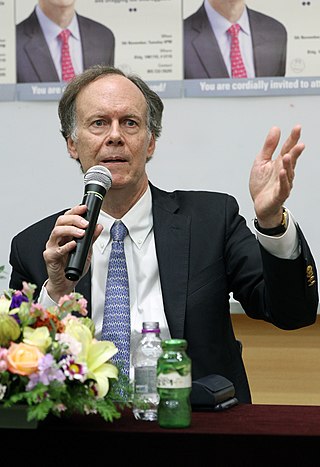
William G. Kaelin Jr. is an American Nobel laureate physician-scientist. He is a professor of medicine at Harvard University and the Dana–Farber Cancer Institute. His laboratory studies tumor suppressor proteins. In 2016, Kaelin received the Albert Lasker Award for Basic Medical Research and the AACR Princess Takamatsu Award. He also won the Nobel Prize in Physiology or Medicine in 2019 along with Peter J. Ratcliffe and Gregg L. Semenza.

Sónia Maria Campos Soares da Rocha, usually referred to as Professor Sónia Rocha, is a Portuguese cell biologist who holds a personal chair in biochemistry at the University of Liverpool, where she is the head of the Department of Biochemistry. Rocha runs an active multidisciplinary cell signaling research group studying hypoxia, and focused around transcription factors such as Hypoxia-inducible factors and NF-κB. Her laboratory is currently based in the Institute of Integrative Biology.





